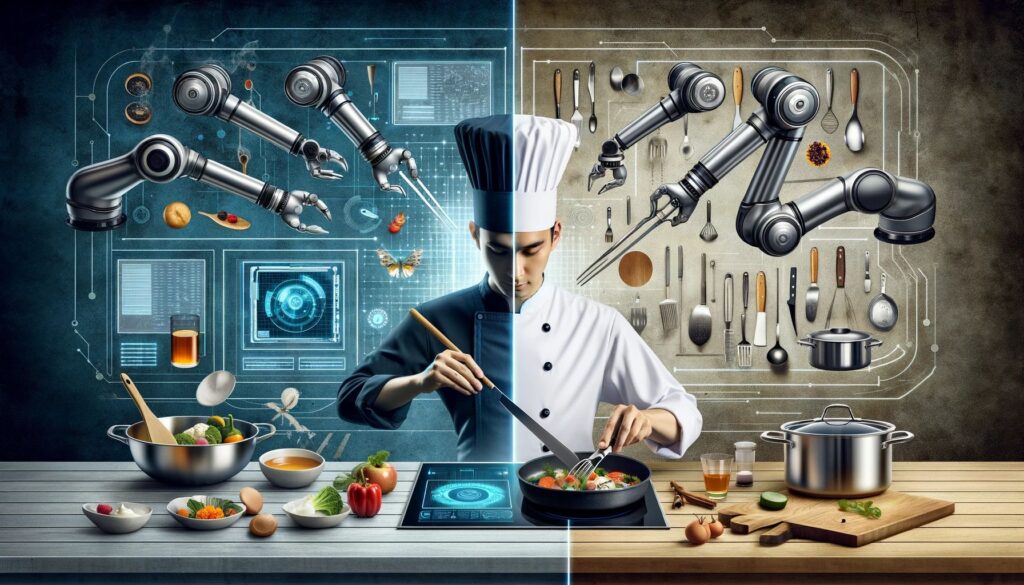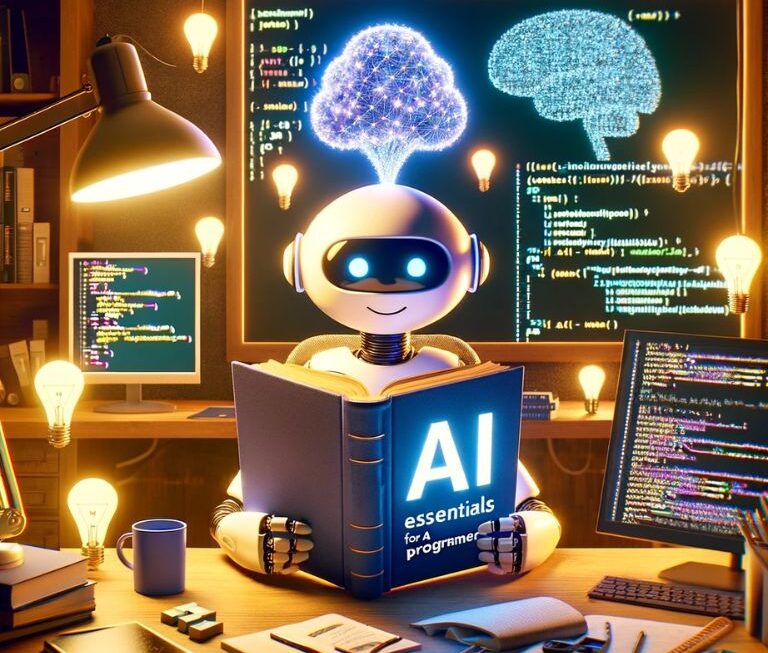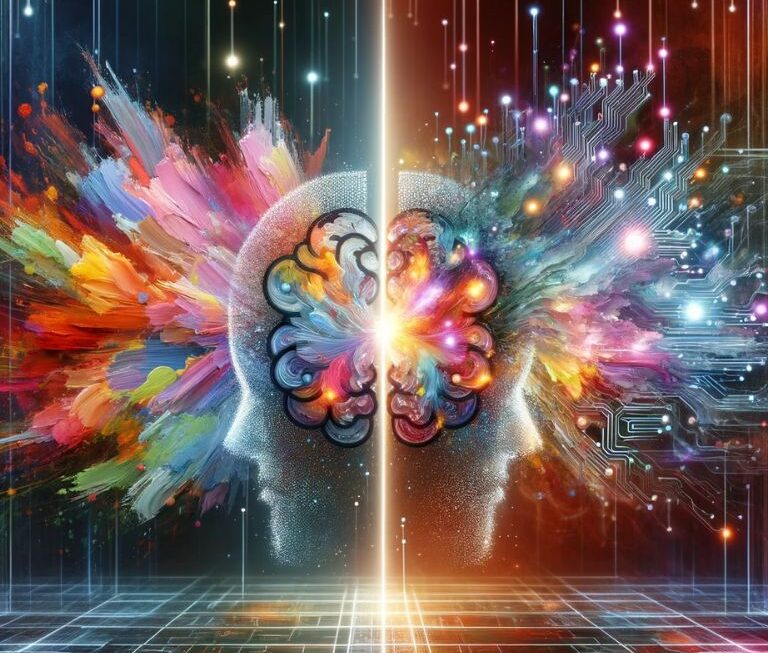The culinary world is undergoing a remarkable transformation, driven by the advent of Artificial Intelligence (AI). This integration of technology into the realm of cooking and flavor creation marks a significant shift from traditional culinary practices to a new era where technology and taste intertwine. In this section, we delve into how AI is reshaping the culinary arts, bringing a fusion of data-driven precision and creative flair to the kitchen.
The Evolution of Culinary Practices
Culinary arts have always been a blend of science and creativity. Historically, chefs relied on their intuition, experience, and traditional techniques to craft dishes. However, the digital age has ushered in a new player: AI. This technology is not about replacing the chef but augmenting their capabilities. AI in the kitchen represents a synergy between human culinary skills and machine intelligence, leading to unprecedented innovations in food preparation and recipe development.
AI: A New Ingredient in the Kitchen
AI’s role in culinary arts is multifaceted. It involves analyzing vast datasets about flavor compounds, regional cuisines, dietary needs, and consumer preferences. This analysis leads to the creation of novel recipes and flavor combinations that might not be intuitive to human chefs. For instance, IBM’s Chef Watson, an AI system, can create recipes by analyzing thousands of ingredients and understanding how their flavors and aromas complement each other.
| AI Technology | Description | Notable Contributions |
|---|---|---|
| IBM Chef Watson | An AI system that creates new recipes by analyzing flavor compounds. | Developed unique recipes like Baltic apple pie and Austrian chocolate burrito. |
| Google’s DeepMind | Uses machine learning to understand food preferences and nutrition. | Assists in creating personalized diet plans and sustainable menus. |
| AI-Powered Cooking Robots | Robots equipped with AI algorithms to assist in cooking. | Precision in cooking techniques, consistency in quality, and efficiency in high-volume kitchens. |
Transforming the Culinary Landscape
The impact of AI in culinary arts extends beyond just creating new recipes. It’s about understanding the science of flavors and textures, leading to a more sophisticated approach to cooking. AI tools can suggest ingredient substitutions, optimize nutritional content, and even predict consumer taste preferences. This technology is not just a tool for high-end restaurants; it’s becoming increasingly accessible, offering possibilities for home cooks and food enthusiasts to explore new culinary horizons.
As we embark on this journey through the AI-infused culinary landscape, it’s clear that the fusion of technology and traditional cooking methods is not just a fleeting trend but a fundamental shift in how we approach food. AI in culinary arts is redefining the boundaries of creativity and science in cooking, promising a future where our meals are not only delicious but also intelligently crafted to suit our tastes and nutritional needs.
The Science Behind AI-Driven Culinary Innovations
The integration of Artificial Intelligence (AI) in the culinary arts is not just a technological novelty; it’s a scientific endeavor that’s reshaping how we understand and create food. This section explores the intricate science behind AI-driven culinary innovations, highlighting how algorithms and data analytics are becoming essential tools in the modern kitchen.
Understanding AI Algorithms in Flavor Analysis
At the heart of AI’s culinary applications is the ability to analyze and interpret complex data related to flavors and ingredients. AI systems use machine learning algorithms to process vast amounts of information on flavor compounds, cooking methods, and ingredient interactions. This data-driven approach enables AI to identify patterns and combinations that might elude even the most experienced chefs.
For example, an AI system can analyze the chemical structure of ingredients to predict how they will interact when combined. This capability allows for the creation of unique and harmonious flavor profiles, pushing the boundaries of traditional culinary practices.
AI-Generated Recipes
Several high-profile projects have demonstrated the potential of AI in recipe creation. Here are a few notable examples:
- IBM Chef Watson: This AI system gained fame for creating unconventional recipes by analyzing over 10,000 recipes and understanding the chemistry of different ingredients. Chef Watson has created dishes like Belgian Bacon Pudding and Vietnamese Apple Kebab, showcasing its ability to combine ingredients in novel ways.
- Google’s DeepMind: Known for its prowess in various fields, DeepMind has also ventured into culinary applications. By analyzing food trends and nutritional data, DeepMind aids in creating recipes that are not only innovative but also tailored to dietary needs and preferences.
- AI-Powered Gourmet Apps: Various startups have developed apps that use AI to suggest recipes based on user preferences, available ingredients, and nutritional goals. These apps represent a more consumer-friendly application of AI in everyday cooking.
AI in Recipe Development

- Flavor Compound Analysis
- Function: Analyzes the chemical composition of ingredients to predict flavor pairings.
- Impact on Culinary Arts: Leads to innovative and unexpected flavor combinations.
- Nutritional Optimization
- Function: Uses AI to balance taste with nutritional value in recipes.
- Impact on Culinary Arts: Helps in creating healthier yet flavorful dishes.
- Consumer Preference Prediction
- Function: Analyzes consumer data to predict popular flavors and trends.
- Impact on Culinary Arts: Assists chefs and food companies in tailoring their offerings to current tastes.
The Role of AI in Sensory Experience
Beyond just creating recipes, AI plays a crucial role in enhancing the sensory experience of food. By understanding the science behind taste, texture, and aroma, AI can guide chefs in crafting dishes that not only taste good but also appeal to the other senses. This holistic approach to cooking is leading to a more immersive and satisfying dining experience.
The science behind AI-driven culinary innovations is a testament to the power of technology in enhancing creativity and precision in cooking. As AI continues to evolve, its role in the culinary arts is set to expand, offering endless possibilities for chefs and food enthusiasts alike. The future of cooking is not just about the ingredients we use but how we use technology to bring out the best in them.
AI and the Art of Flavor Pairing
The advent of Artificial Intelligence (AI) in the culinary world has revolutionized the art of flavor pairing, a cornerstone of gastronomy. This section explores how AI is enabling chefs and food enthusiasts to discover and experiment with unique and unexpected flavor combinations, enhancing the sensory experience of dining.
AI’s Approach to Flavor Pairing
Traditional flavor pairing is often guided by cultural practices and chef intuition. However, AI introduces a data-driven approach, analyzing the chemical components of ingredients to suggest pairings that might seem unconventional yet are scientifically harmonious. This method is based on the principle that ingredients sharing key flavor compounds are more likely to taste good together, a concept that AI can explore on a scale far beyond human capability.
Innovative Flavor Combinations Crafted by AI
AI’s ability to sift through extensive databases of ingredients and their flavor profiles has led to some truly innovative pairings. For instance, AI systems have suggested combinations like strawberry and mushroom or chocolate and blue cheese, which, while unconventional, create a unique and delightful taste experience.
AI-Generated Flavor Pairings
- Coffee & Garlic
- AI System: IBM Chef Watson
- Description: A surprising yet harmonious pairing, used in savory dishes.
- Chocolate & Blue Cheese
- AI System: AI Culinary Database
- Description: A bold combination that balances sweet and savory notes.
- Strawberry & Mushroom
- AI System: Experimental AI Model
- Description: An unusual pairing that brings together earthy and sweet flavors.
Enhancing Sensory Experiences with AI
AI’s role in flavor pairing extends beyond just combining ingredients; it’s about creating a complete sensory experience. By understanding the science behind how we perceive taste, AI can guide the creation of dishes that not only taste good but also stimulate other senses, such as smell and sight. This holistic approach to cooking is leading to more immersive and memorable dining experiences.
AI’s Impact on Culinary Creativity
While some may fear that AI could stifle culinary creativity, the opposite is often true. AI serves as a tool that can inspire chefs to explore new territories in flavor and texture. By suggesting unexpected combinations, AI pushes the boundaries of traditional cooking and encourages chefs to experiment and innovate.
AI’s impact on the art of flavor pairing is a testament to the fusion of technology and culinary creativity. By enabling the exploration of new flavor combinations, AI is not only enhancing the dining experience but also expanding the creative horizons of chefs and food enthusiasts. As AI continues to evolve, its influence on the culinary arts promises to bring even more exciting and innovative gastronomic creations to the table.
Technological Tools: AI Platforms in the Kitchen
The integration of Artificial Intelligence (AI) in the culinary arts is not just about conceptual innovations; it’s also about the practical application of AI tools and platforms in the kitchen. This section delves into the various AI technologies being used in recipe development and culinary experimentation, highlighting how chefs and food scientists are collaborating with these advanced tools to push the boundaries of cooking.
Overview of Popular AI Culinary Tools

The landscape of AI culinary tools is diverse, ranging from recipe suggestion algorithms to sophisticated cooking robots. These tools are designed to assist in various aspects of cooking, from ideation to execution. Some popular AI tools in the culinary world include:
- IBM Chef Watson: This AI system is known for its ability to create unique recipes by analyzing thousands of ingredients and their flavor profiles.
- Google’s DeepMind: While famous for its achievements in games like Go and Chess, DeepMind also applies its machine learning capabilities to culinary applications, such as optimizing recipes for taste and nutrition.
- AI-Powered Cooking Robots: These robots use AI algorithms to assist in cooking, ensuring precision and consistency, especially in high-volume commercial kitchens.
Collaboration Between Chefs and AI Technologies
The relationship between chefs and AI is symbiotic. While AI provides data-driven insights and precision, chefs bring creativity and a human touch to the cooking process. This collaboration is leading to a new era of culinary arts where technology and human expertise combine to create exceptional dining experiences.
For instance, some restaurants use AI to analyze customer feedback and modify recipes accordingly, ensuring that the dishes evolve to meet changing tastes and preferences. Similarly, food scientists are working with AI to understand better and improve the nutritional value of meals without compromising on flavor.
AI’s Role in Enhancing Culinary Education and Training
AI is also making its mark in culinary education. Culinary schools are beginning to incorporate AI tools into their curriculum, teaching aspiring chefs how to interact with and leverage these technologies. This education is crucial in preparing the next generation of chefs for a future where AI is an integral part of the culinary landscape.
The use of AI platforms in the kitchen represents a significant step forward in the culinary arts. These tools are not just enhancing the efficiency and precision of cooking but are also opening up new avenues for creativity and innovation. As AI technology continues to evolve, its role in the culinary world is set to become even more prominent, shaping the future of how we cook and experience food.
Ethical and Sustainable Cooking with AI
In recent years, the focus on ethical and sustainable practices in the culinary world has intensified. Artificial Intelligence (AI) is playing a pivotal role in this movement, offering innovative solutions to promote sustainability and ethical food practices. This section explores how AI is being used to reduce food waste, optimize ingredient usage, and support environmentally friendly cooking methods.
AI’s Role in Promoting Sustainable Food Practices
AI technology is instrumental in tackling some of the most pressing issues in the culinary industry, such as food waste and sustainable sourcing of ingredients. By analyzing data on consumption patterns, supply chain logistics, and shelf life of ingredients, AI can help in reducing waste and improving the overall efficiency of food production and distribution.
For instance, AI systems can predict which menu items are likely to be more popular, allowing restaurants to adjust their ingredient purchasing accordingly. This not only reduces food waste but also ensures that the ingredients are fresh and of high quality.
Examples of AI in Reducing Food Waste
Several initiatives and projects demonstrate AI’s potential in promoting sustainable cooking practices:
- AI-Powered Inventory Management Systems: These systems help restaurants and food retailers manage their inventory more effectively, reducing overstocking and food spoilage.
- AI in Agricultural Practices: AI is used to optimize farming practices, ensuring that crops are grown sustainably and harvested at the right time to maximize yield and minimize waste.
- AI for Sustainable Menu Planning: Some AI tools assist chefs in creating menus that are not only delicious but also environmentally friendly, using ingredients that are in season and locally available.
Ethical Considerations in AI-Driven Culinary Practices
While AI offers numerous benefits in promoting sustainability, it’s important to consider the ethical implications of its use in the culinary industry. Issues such as data privacy, job displacement, and the potential for AI to perpetuate certain food trends at the expense of traditional cooking methods are areas of ongoing discussion and consideration.
AI’s contribution to ethical and sustainable cooking practices is a significant advancement in the culinary arts. By reducing food waste, optimizing ingredient usage, and supporting sustainable farming practices, AI is helping to create a more sustainable and responsible culinary industry. As AI technology continues to evolve, its role in promoting ethical and environmentally friendly cooking practices is expected to grow, shaping the future of how we approach food production and consumption.
The Future of Dining: AI-Infused Culinary Experiences
As we look towards the future, it’s clear that Artificial Intelligence (AI) will continue to play a transformative role in the culinary arts. This section explores the potential future developments and innovations in dining experiences driven by AI, from personalized meals to interactive dining environments.
Predictions on AI’s Continued Transformation of Dining
The integration of AI in the culinary world is not just about enhancing current practices but also about reimagining the future of dining. Here are some ways AI is expected to further revolutionize the culinary landscape:
- Personalized Dining Experiences: AI can analyze individual taste preferences, dietary restrictions, and even health goals to create customized meal plans and recipes. This personalization could extend to restaurants where menus are tailored to each diner’s unique profile.
- Interactive and Immersive Dining: AI technology could lead to more interactive dining experiences, such as augmented reality (AR) menus that visually showcase how dishes are prepared or virtual reality (VR) environments that transport diners to different settings while they enjoy their meal.
- AI in Food Production and Delivery: Advancements in AI could streamline the food production and delivery process, making it more efficient and sustainable. This includes everything from AI-driven agricultural practices to automated food delivery systems.
Challenges and Opportunities
While the future of AI in dining presents exciting possibilities, it also comes with its set of challenges. Ensuring data privacy, maintaining the human element in culinary arts, and addressing potential job displacements are areas that need careful consideration. However, these challenges also present opportunities for innovation and the development of ethical AI practices in the culinary field.
The future of dining, infused with AI, promises a world where culinary experiences are more personalized, immersive, and sustainable. As AI continues to evolve, its potential to transform every aspect of dining – from meal preparation to the overall dining experience – is immense. Embracing these changes while addressing the challenges will be key to realizing the full potential of AI in the culinary arts.
Challenges and Considerations in AI-Driven Culinary Arts
While the integration of Artificial Intelligence (AI) in the culinary world offers numerous benefits and exciting possibilities, it also presents certain challenges and considerations that need to be addressed. This section explores the limitations, ethical concerns, and the balance between technology and traditional culinary skills in the context of AI-driven culinary arts.
Addressing the Limitations of AI in Cooking
AI, while powerful, is not without its limitations in the culinary field. One of the primary challenges is the inability of AI to fully replicate the human senses and intuition that play a crucial role in cooking. For instance, AI can suggest flavor combinations and recipes based on data, but it cannot taste or smell, which are essential aspects of culinary artistry.
Another limitation is the potential for AI to homogenize culinary experiences. While AI can analyze trends and popular flavors, there’s a risk of losing regional and cultural uniqueness in dishes if AI-driven standardization takes precedence.
Balancing Technology with Traditional Skills

The integration of AI in culinary arts raises questions about the balance between technology and traditional cooking skills. Maintaining the human touch in cooking is crucial, even as AI enhances efficiency and precision. Chefs should use AI to augment, not replace, their culinary skills, enhancing rather than supplanting human expertise.
Ethical Considerations in AI-Driven Culinary Practices
The use of AI in culinary arts also brings up ethical considerations. Critical issues include data privacy in personalized dining, job displacement risks, and responsible data sourcing in the culinary industry. Ensuring that AI is used in a way that respects privacy, promotes sustainability, and supports the culinary community is essential.
| Challenge/Consideration | Description | Potential Solutions |
| Limitation in Sensory Analysis | AI cannot taste or smell. | Combine AI with human sensory evaluation. |
| Risk of Homogenization | AI might standardize flavors, losing cultural uniqueness. | Use AI to highlight and preserve regional cuisines. |
| Ethical Concerns | Issues around data privacy and job displacement. | Develop ethical guidelines and policies for AI use in culinary arts. |
The challenges and considerations in AI-driven culinary arts are as important as the innovations and advancements. Addressing these issues requires a collaborative approach, involving chefs, technologists, ethicists, and consumers. Acknowledging and addressing challenges allows the culinary world to maximize AI’s potential while maintaining traditional cooking’s essence and ethics.
The Ongoing Culinary Revolution
AI’s integration into the culinary arts is revolutionizing food preparation, from innovative recipes to personalized dining. Beyond being a technological novelty, it’s ushering in a new era of creativity and precision. AI in culinary arts promises personalized nutrition, sustainable food production, and immersive dining experiences. This collaboration among AI developers, chefs, and food scientists highlights the dynamic nature of culinary innovation. Balancing AI’s innovation with human touch and preserving food’s cultural essence. AI is set to play a key role in creating sustainable, personalized, and engaging culinary experiences.




